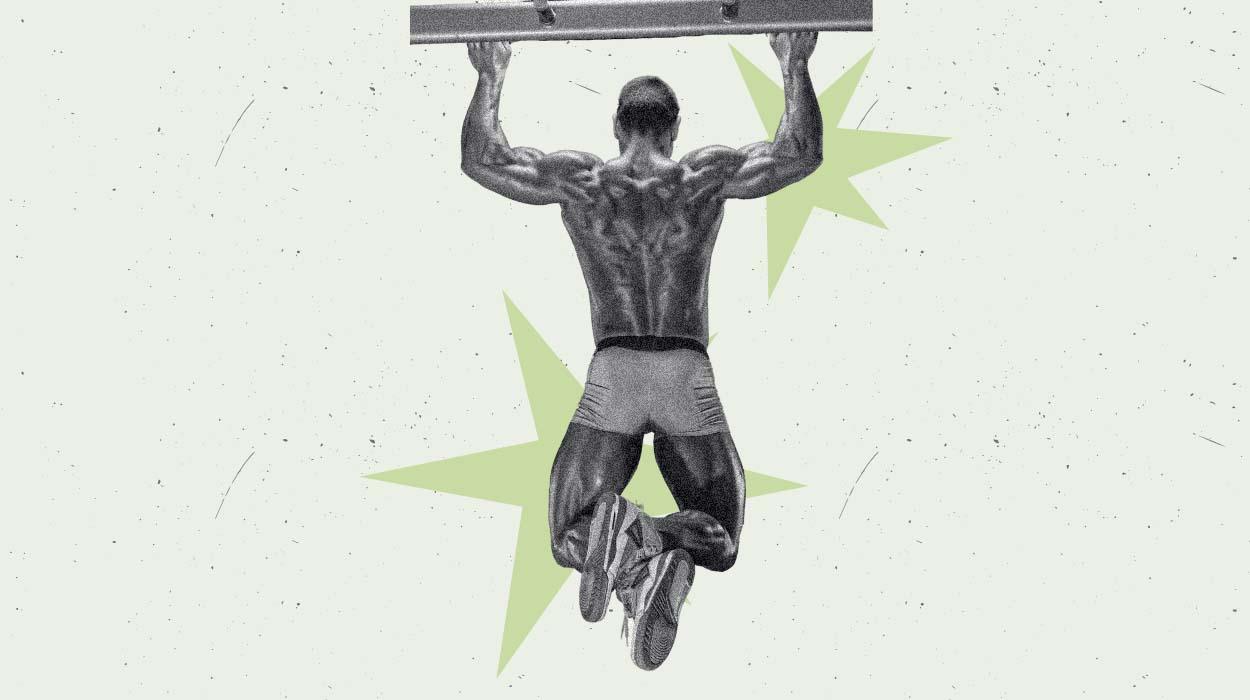
The lat pulldown[1] is one of the most identifiable lat exercises. But vertical pulling exercises aren’t the only option when it comes to training your back, as many other types of exercises can target the same muscle groups. We’ve compiled a list of the 10 best lat pulldown alternative exercises you can try today.
Top 10 Lat Pull Down Alternatives
The latissimus dorsi muscles (or lats) can be targeted with exercises other than lat pull-downs. Here’s a list of the 10 best lat pulldown alternative exercises:
10 Best Lat Pulldown Alternative Exercises
Here’s a list of lat pulldown alternative exercises that you can do at the gym in place of lat pull-downs.
Dumbbell Pullovers
The Dumbbell Pullovers exercise is a versatile movement that primarily targets the muscles of the chest, back, and triceps. Dumbbell Pullovers are an excellent addition to your upper body workout routine, helping you build a strong and balanced physique while also contributing to improved posture and core stability.
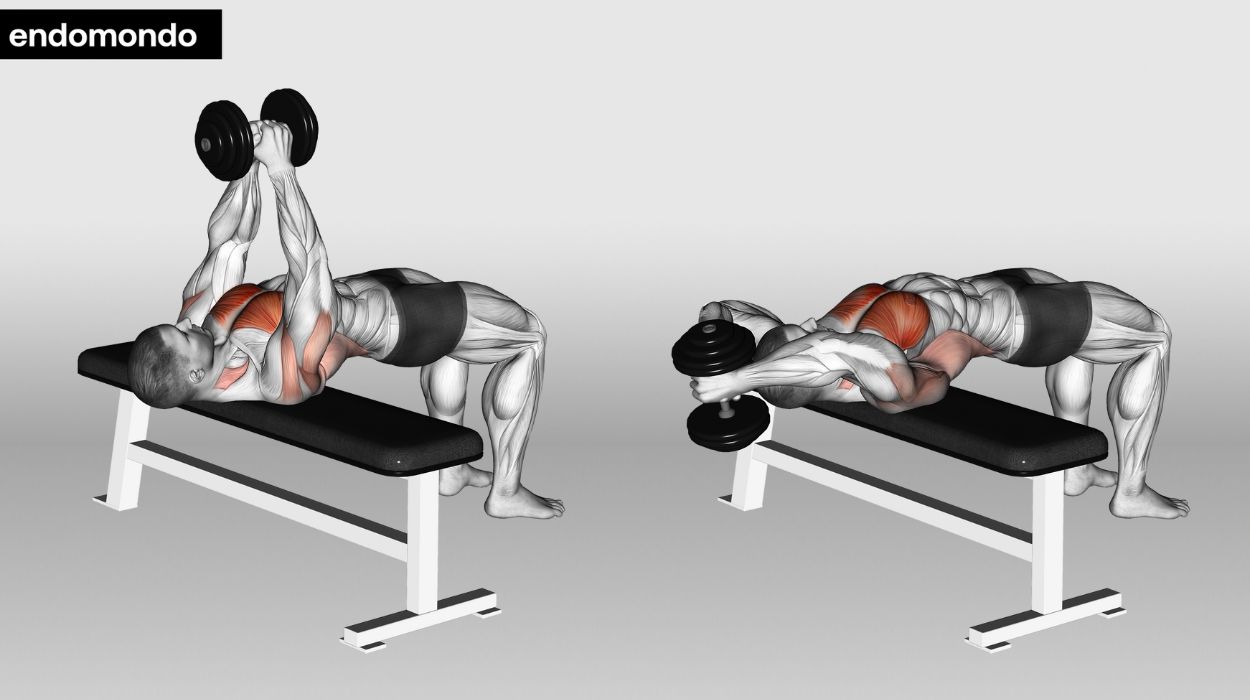
How to do:
- Begin by lying on your back on a flat bench, so that only your upper back and shoulders are supported by the bench, and your feet are flat on the floor.
- Hold a dumbbell with both hands, palms pressing against the underside of one end of the dumbbell, and extend your arms straight up over your chest.
- Keep a slight bend in your elbows, and maintain a firm grip on the dumbbell.
- Lower the dumbbell backward and overhead in a controlled arc, maintaining a slight bend in your elbows.
- Inhale as you lower the dumbbell, and aim to go as far as your shoulder mobility allows, feeling a stretch in your chest and legs.
- Once you reach the lowest comfortable point, reverse the movement and exhale as you bring the dumbbell back to the starting position over your chest.
- Focus on using your chest and lats to control the movement rather than your arms.
- Repeat the pullover for the desired number of repetitions while maintaining proper form and control.
- Engage your core throughout the exercise to stabilize your spine and maintain balance on the bench.
Tips:
- Be careful not to arch your back when doing a dumbbell pullover.
- Keep your core engaged throughout the exercise to support your lower back and maintain stability.
- Avoid excessive stretching when lowering the dumbbell behind your head to prevent strain on the shoulder joints.
Optimal Sets and Reps: 3 sets of 10-12 reps.
Single-Arm Cable Pulldown
The Single-Arm Cable Pulldown is a highly effective exercise that targets the latissimus dorsi muscles (lats) and helps in strengthening the back and improving overall upper body strength. It involves using a cable machine with a single-handle attachment to perform a pulling motion. By isolating one arm at a time, this exercise allows for greater focus and control over the movement, helping to develop symmetry and balance in the back muscles.
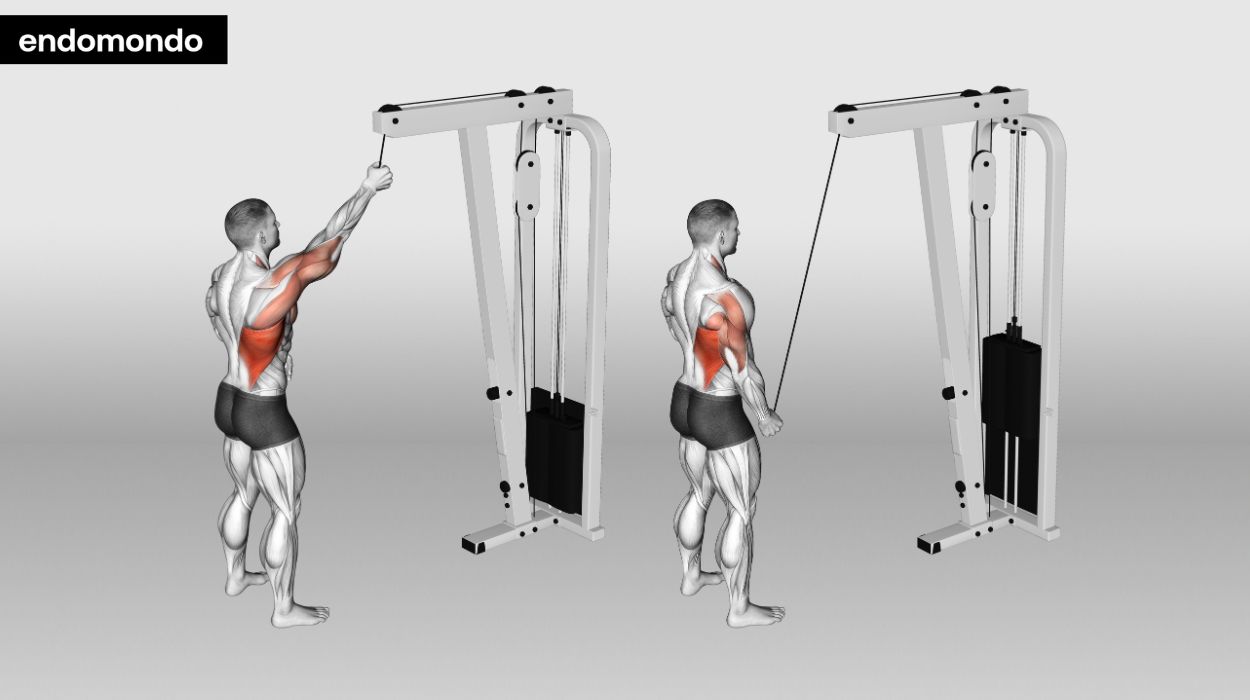
How to do:
- Begin by setting up a cable machine with a high pulley attachment and attaching a single-grip handle.
- Stand facing the machine and adjust the weight to an appropriate resistance level.
- Grip the handle with one hand, palm facing down, and position yourself a few steps away from the machine to create tension in the cable.
- Take a staggered stance, with one foot slightly in front of the other for balance.
- Start with your arm fully extended and your hand slightly above shoulder height.
- Engage your core and keep your back straight as you initiate the movement by pulling the handle down towards your hip, and bending your elbow.
- Focus on using your latissimus dorsi muscle (lats) to perform the pull, squeezing your shoulder blades together at the bottom of the movement.
- Once your hand is near your hip, hold the position for a brief pause to maximize the contraction.
- Slowly release the handle back to the starting position, allowing your arm to fully extend while maintaining control.
- Repeat the single-arm cable pulldown for the desired number of repetitions, then switch to the other arm.
- Maintain proper form and control throughout the exercise, and keep your core engaged for stability.
Tips:
- Sit upright with your back straight and core engaged to stabilize your spine and prevent excessive leaning or swinging during the movement.
- Concentrate on contracting your latissimus dorsi muscle as you pull the handle down, ensuring a full range of motion to engage and strengthen the target muscles effectively.
- Use a weight that allows you to perform with proper form, gradually increasing the resistance as you progress.
Optimal Sets and Reps: 3 sets of 10-12 reps.
Barbell Rows
Barbell Rows are a compound strength-training exercise that primarily targets the muscles in your upper back, including the latissimus dorsi (lats), rhomboids, and trapezius. This exercise involves bending at the hips while maintaining a straight back and pulling a loaded barbell towards your abdomen, engaging your back muscles and providing significant benefits for overall upper body strength and muscle development. Barbell Rows are a versatile addition to any strength training routine and can help improve posture, increase back strength, and enhance functional fitness.
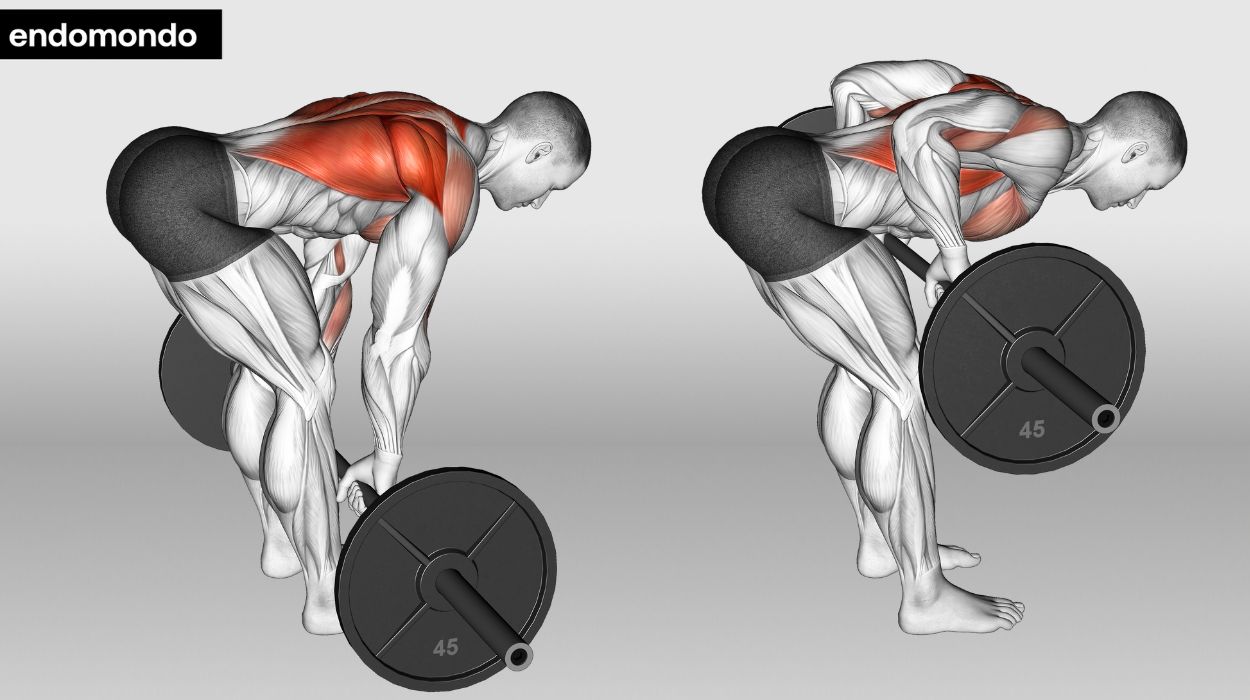
How to do:
- Begin by standing with your feet shoulder-width apart and a barbell on the floor in front of you.
- Bend at your hips and knees to lower your upper body until it’s almost parallel to the ground, keeping your back straight and chest up.
- Bend your knees enough to allow you to grip the barbell with an overhand grip (palms facing down), hands slightly wider than shoulder-width apart.
- Lift the barbell off the ground by straightening your hips and knees, keeping your back flat and arms fully extended.
- With the barbell in your hands, retract your shoulder blades and keep your chest up as you begin the movement.
- Exhale as you pull the barbell towards your lower ribcage by bending your elbows and driving them back.
- Squeeze your upper back muscles, especially your lats, at the top of the movement, and hold for a brief pause.
- Lower the barbell back down to the starting position in a controlled manner, inhaling as you extend your arms.
- Repeat the barbell rows for the desired number of repetitions while maintaining proper form and control.
- Engage your core throughout the exercise to stabilize your spine and prevent excessive arching or rounding of your back.
Tips:
- Keep your back straight and chest up throughout the movement to avoid rounding your spine, ensuring proper engagement of your back muscles and reducing the risk of injury.
- Hold the barbell with an overhand grip slightly wider than shoulder-width apart to target your back effectively and promote balanced muscle engagement.
- Start with a weight that allows you to complete with good form, gradually increasing the resistance as you become more comfortable with the exercise.
Optimal Sets and Reps: 3 sets of 10-12 reps.
Single-Arm Dumbbell Row
The Single-Arm Dumbbell Row is a fundamental strength-training exercise that primarily targets the muscles in your upper back, including the latissimus dorsi, rhomboids, and trapezius. This exercise involves lifting a dumbbell with one hand while supporting your body with the opposite leg and hand on a bench, effectively isolating and strengthening the targeted muscle groups.
Single-arm dumbbell rows are excellent for building back strength, improving posture, and enhancing overall upper-body muscular balance. Proper form and controlled movements are essential to reap the full benefits of this exercise while minimizing the risk of injury.
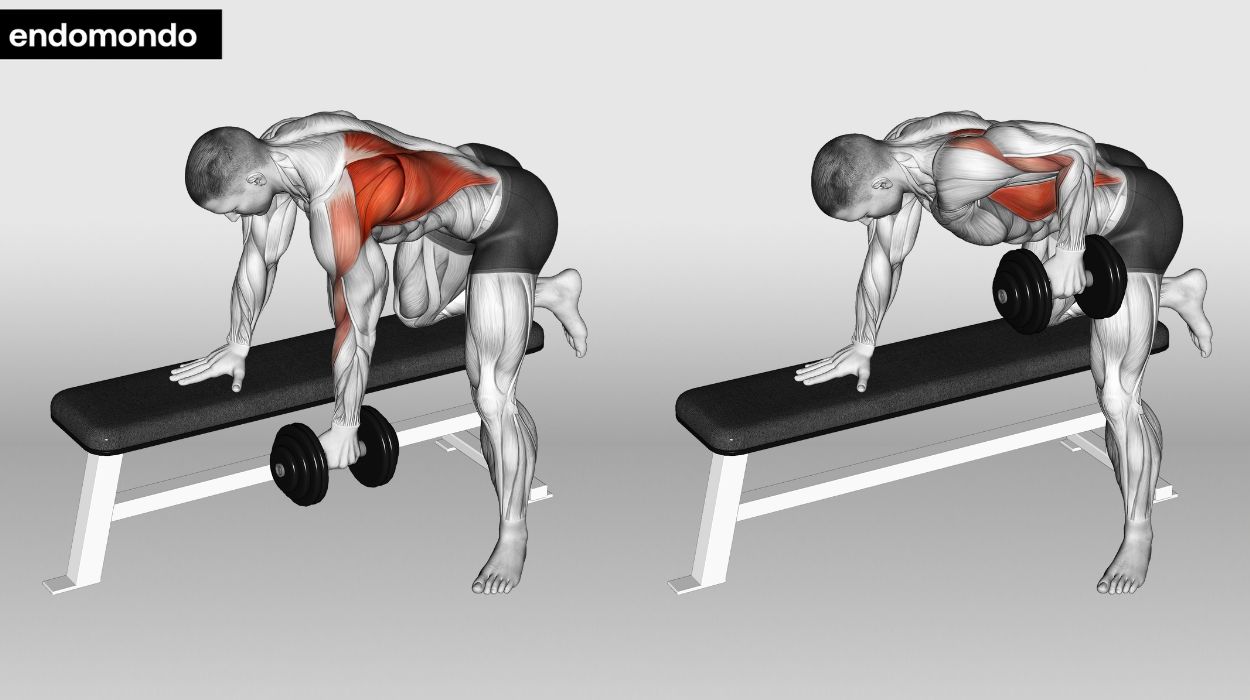
How to do:
- Begin by placing a dumbbell on the floor next to a flat bench.
- Stand facing the bench and place your right knee and right hand on the bench, ensuring your back is parallel to the floor.
- Reach down and pick up the dumbbell with your left hand, palm facing your torso.
- Keep your back straight, chest up, and head in line with your spine.
- Allow your left arm to hang straight down, fully extended.
- Initiate the movement by pulling the dumbbell upward toward your hip, bending your elbow, and retracting your shoulder blade.
- Exhale as you lift the dumbbell, and focus on using your latissimus dorsi (lat) muscle to perform the pull.
- Squeeze your lat at the top of the movement, holding for a brief pause.
- Lower the dumbbell back down to the starting position in a controlled manner, inhaling as you extend your arm.
- Repeat the single-arm dumbbell row for the desired number of repetitions on one side before switching to the other.
- Maintain proper form and control throughout the exercise, and engage your core to stabilize your body.
Tips:
- Keep your back flat and core engaged to maintain proper posture throughout the exercise, preventing strain on your lower back.
- Focus on pulling the dumbbell towards your hip while squeezing your shoulder blade to maximize the engagement of your lat muscles.
- Control the weight on both the lifting and lowering phases to ensure a full range of motion and target your back muscles effectively.
Optimal Sets and Reps: 3 sets of 10-12 reps.
Pull-Ups
Pull-ups are similar to a traditional lat pulldown but you get the advantage of using body weight. You can even have a pull-up bar at home! Grab the bar with a shoulder-width overhand grip (hands placed on the bar shoulder distance apart, palms facing away from you) and pull yourself up as high as you can.
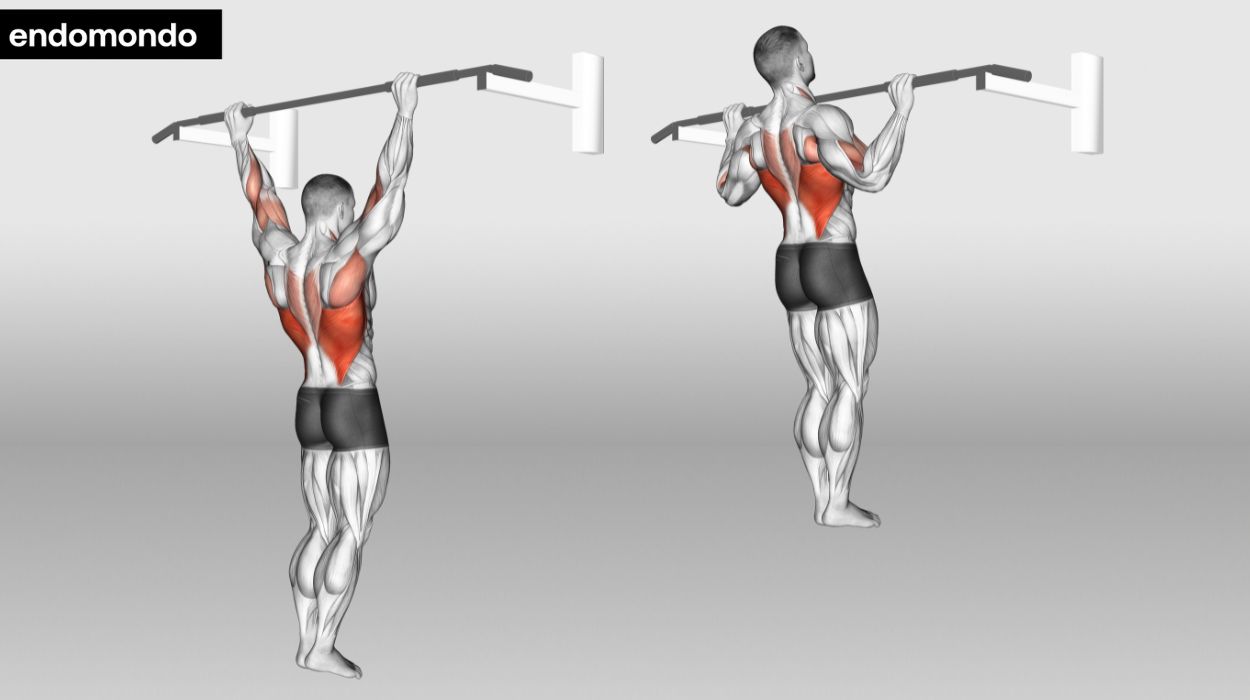
How to do:
- Find a sturdy horizontal bar, such as a pull-up bar, and ensure it can support your body weight.
- Stand facing the bar with your feet together and your palms facing away from you (overhand grip).
- Reach up and grasp the bar with your hands slightly wider than shoulder-width apart.
- Hang from the bar with your arms fully extended and your shoulders relaxed.
- Engage your core and pull your shoulder blades down and back to prepare for the movement.
- Begin the exercise by pulling your body upward toward the bar, exhaling as you do so.
- Focus on using your back and arm muscles to lift your body until your chin is above the bar.
- Squeeze your back muscles at the top of the movement and hold for a brief pause.
- Lower your body back down in a controlled manner, inhaling as you extend your arms.
- Repeat the pull-up for the desired number of repetitions while maintaining proper form and control.
- Engage your core throughout the exercise to stabilize your body and prevent swinging.
Tips:
- Start with a comfortable grip width and progressively widen it as you become more advanced.
- Avoid swinging or using momentum; focus on controlled movements.
- If you’re unable to do a full pull-up initially, work on negatives by jumping up to the top position and lowering yourself slowly.
Optimal Sets and Reps: 3 sets of 10-12 reps.
Chin-Ups
Similar to a pull-up but you’ll grab the bar with a shoulder-width underhand grip (hands placed on the bar shoulder distance apart, palms turned towards you) and pull yourself up as high as you can.
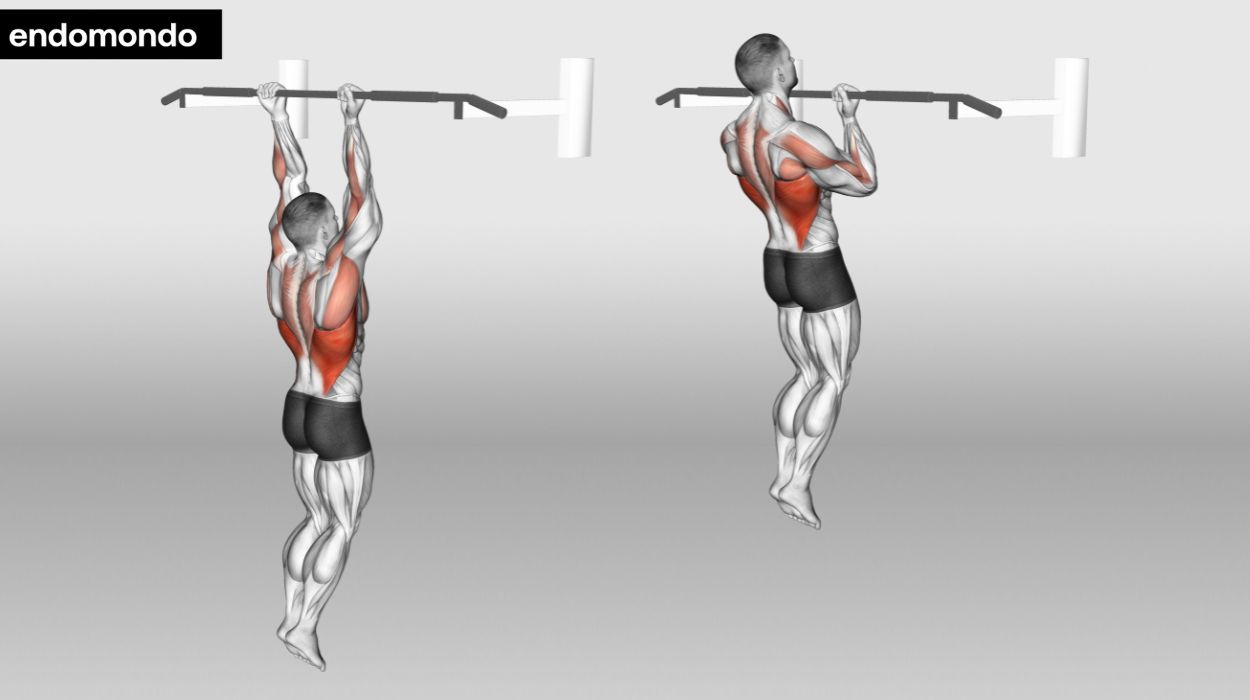
How to do:
- Find a sturdy horizontal bar, such as a pull-up bar, and ensure it can support your body weight.
- Stand facing the bar with your feet together and your palms facing you (underhand grip).
- Reach up and grasp the bar with your hands shoulder-width apart or slightly narrower.
- Hang from the bar with your arms fully extended and your shoulders relaxed.
- Engage your core and pull your shoulder blades down and back to prepare for the movement.
- Begin the exercise by pulling your body upward toward the bar, exhaling as you do so.
- Focus on using your back and arm muscles to lift your body until your chin is above the bar.
- Squeeze your back muscles at the top of the movement and hold for a brief pause.
- Lower your body back down in a controlled manner, inhaling as you extend your arms.
- Repeat the chin-up for the desired number of repetitions while maintaining proper form and control.
- Engage your core throughout the exercise to stabilize your body and prevent swinging.
Tips:
- Start with a comfortable grip width and progressively widen it as you become more advanced.
- Avoid swinging or using momentum; focus on controlled movements.
- If you’re unable to do a full chin-up initially, work on negatives by jumping up to the top position and lowering yourself slowly.
Optimal Sets and Reps: 3 sets of 10-12 reps.
T Bar Row
A T bar is a machine specifically designed for this type of row. Lean against the chest pad of the machine and use a wide grip. This machine will have you start with your arms extended straight out in front of you. Pull the bar towards you to target your upper back muscles and rear delts.
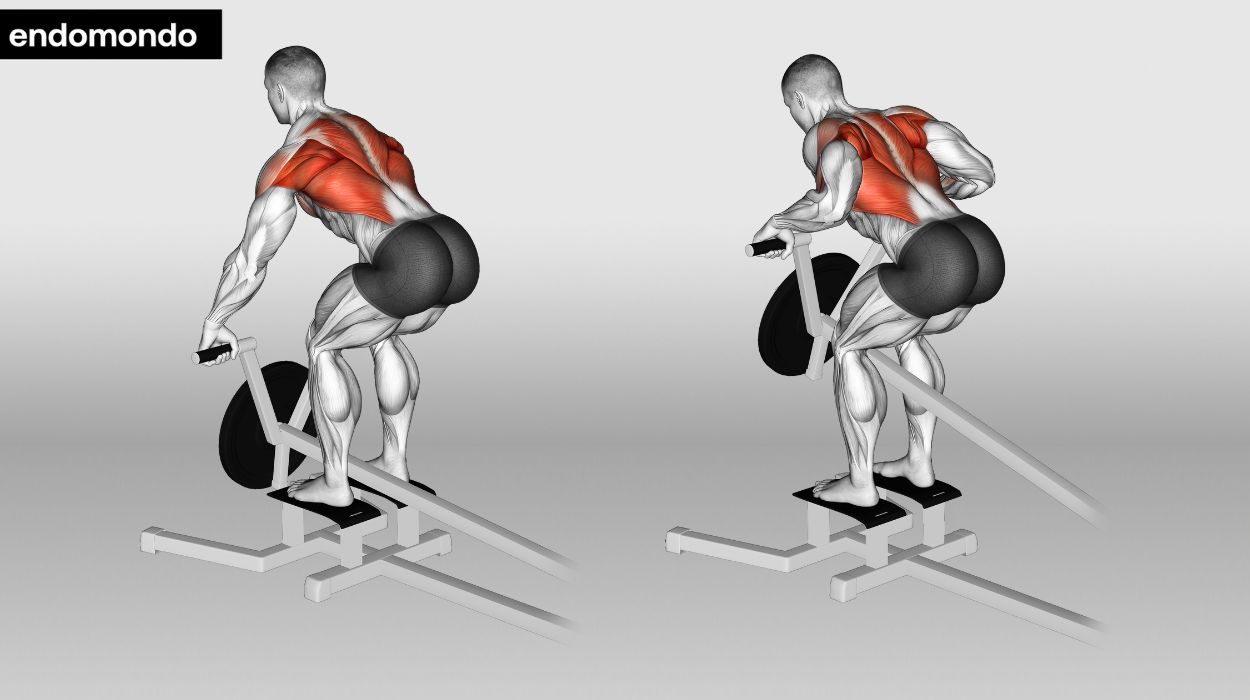
How to do:
- Begin by placing a T-bar row machine or landmine attachment in a secure position with a barbell loaded with the desired weight.
- Straddle the barbell, standing with your feet shoulder-width apart.
- Bend at your hips and knees to lower your upper body until it’s roughly parallel to the ground, keeping your back straight and chest up.
- Reach down and grip the handles or the barbell with both hands, palms facing each other, and your arms fully extended.
- Ensure your back is flat and your head is in line with your spine.
- Initiate the movement by pulling the barbell upward toward your hip, bending your elbows and retracting your shoulder blades.
- Exhale as you lift the barbell and focus on using your back muscles, especially your lats, to perform the pull.
- Squeeze your back muscles at the top of the movement, holding for a brief pause.
- Lower the barbell back down to the starting position in a controlled manner, inhaling as you extend your arms.
- Repeat the T-Bar Row for the desired number of repetitions while maintaining proper form and control.
- Engage your core throughout the exercise to provide stability and prevent swaying or arching of the back.
Tips:
- Keep your core engaged throughout the exercise to stabilize your spine.
- Avoid using excessive momentum or swinging; concentrate on using your back muscles.
- Experiment with different grip widths to target various areas of your back.
Optimal Sets and Reps: 3 sets of 10-12 reps.
Cable Row
The Cable Row is a highly effective compound exercise that primarily targets the muscles in your upper back, including the latissimus dorsi. It’s a versatile strength-training exercise that can help improve posture, increase back muscle mass, and enhance overall upper body strength.
By using a cable machine with a V-bar attachment, you can perform controlled pulling motions to engage your back muscles and promote a strong, well-defined upper back. Incorporating Cable Rows into your workout routine can contribute to better posture, increased functional strength, and a more sculpted upper body.
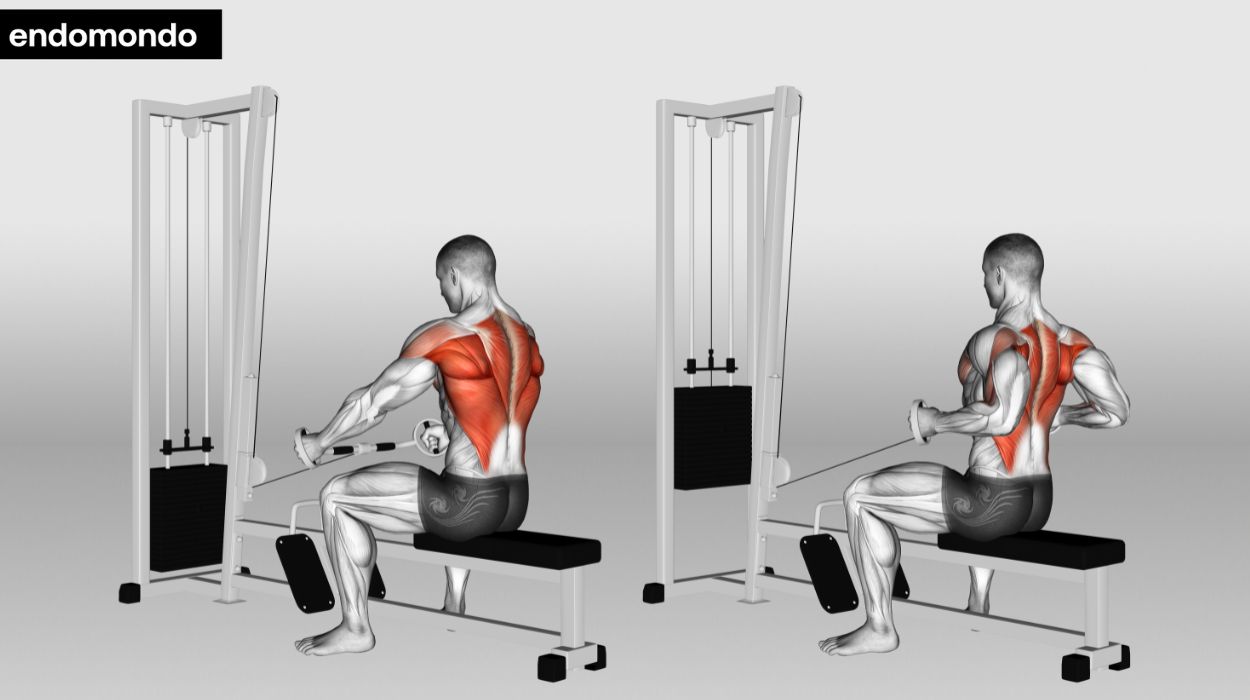
How to do:
- Begin by setting up a cable row machine with a V-bar attachment and selecting an appropriate weight.
- Sit on the bench or platform, facing the machine, and place your feet on the footrests, keeping your knees slightly bent.
- Reach forward and grasp the V-bar with both hands, palms facing each other, and your arms fully extended.
- Sit up straight with a slight arch in your lower back, and pull your shoulder blades back and down.
- Initiate the movement by pulling the V-bar towards your lower ribcage, bending your elbows and squeezing your shoulder blades together.
- Exhale as you perform the row, focusing on using your back muscles, especially your lats.
- Squeeze your back muscles at the end of the movement, holding for a brief pause.
- Slowly release the V-bar and extend your arms to return to the starting position, inhaling as you do so.
- Repeat the Cable Row for the desired number of repetitions while maintaining proper form and control.
- Engage your core throughout the exercise to stabilize your spine and maintain a neutral posture.
Tips:
- Maintain proper posture throughout the exercise, avoiding rounding or arching your back.
- Exhale as you pull the handle towards your abdomen and inhale as you return to the starting position.
- Focus on the mind-muscle connection, feeling your upper back muscles working.
Optimal Sets and Reps: 3 sets of 10-12 reps.
Inverted Row
Inverted Row exercise is distinguished for its ability to target the musculature of the upper back, shoulders, and biceps, concurrently engaging the core. Suitable for individuals of all fitness levels, from novices to seasoned practitioners, the Inverted Row is an adaptable and invaluable addition to your workout regimen.
Its merits lie in its capacity to enhance upper body strength, posture refinement, and overall muscular endurance. Let us embark on the journey of mastering this exercise, a critical step toward achieving your fitness objectives.
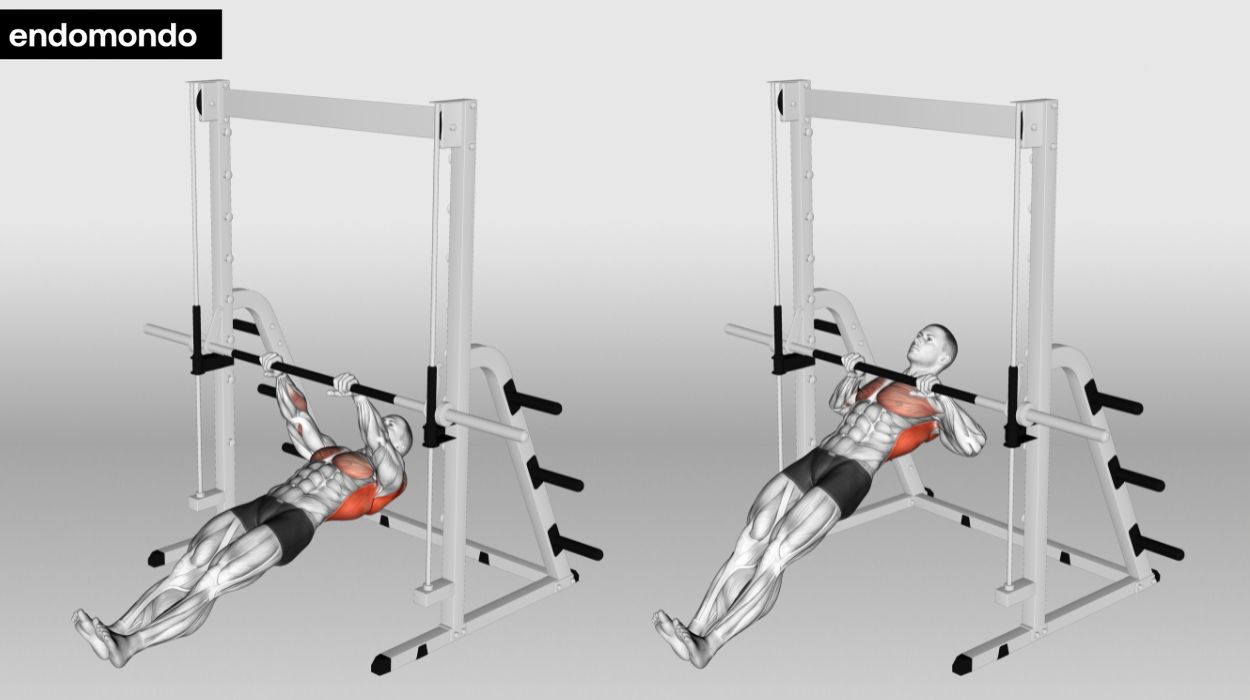
How to do:
- Set up a bar at waist height on a squat rack or use a suspension trainer like TRX and adjust it to an appropriate height.
- Stand facing the bar or suspension trainer, and position your feet hip-width apart.
- Reach forward and grasp the bar or handles with an overhand grip (palms facing away from you) slightly wider than shoulder-width apart.
- Walk your feet forward, leaning back and extending your arms, so that your body is at a slight angle.
- Keep your body straight from head to heels, engage your core, and maintain a neutral spine.
- Initiate the movement by pulling your chest towards the bar or handles, bending your elbows, and squeezing your shoulder blades together.
- Exhale as you perform the row, focusing on using your back muscles, particularly your lats.
- Squeeze your back muscles at the top of the movement and hold for a brief pause.
- Lower your body back down in a controlled manner, inhaling as you extend your arms.
- Repeat the Inverted Row for the desired number of repetitions while maintaining proper form and control.
- Engage your core throughout the exercise to stabilize your spine and prevent excessive arching of your back.
Tips:
- Focus on maintaining a straight line from your head to your heels throughout the exercise.
- Keep your body under control and avoid swinging or using momentum to complete the movement.
- If the exercise is too challenging, you can start with a higher bar or use an incline bench to make it easier.
Optimal Sets and Reps: 3 sets of 10-12 reps.
Resistance Band Lat Pulldown
Resistance bands provide a different challenge than a cable in that the resistance continues to increase throughout the movement. This exercise is a fantastic way to target your latissimus dorsi muscles (those wide muscles on your back) and strengthen your upper body. Whether you’re working out at home or in the gym, resistance bands offer a versatile and effective way to build back strength.
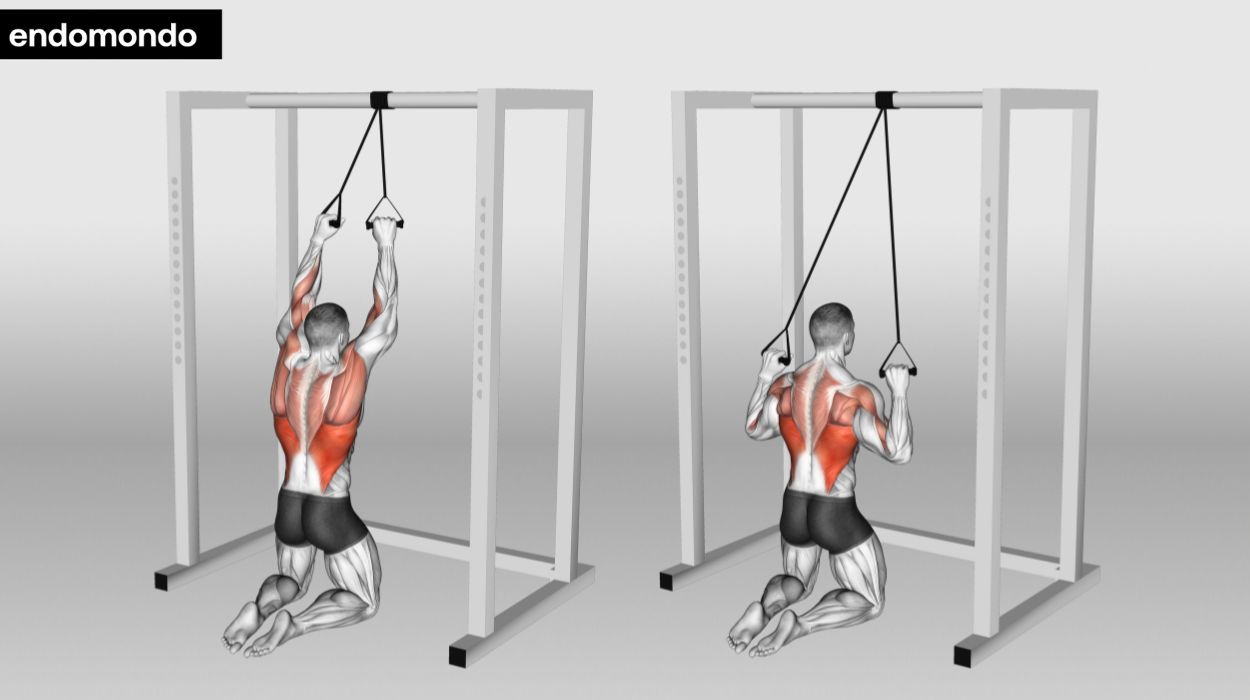
How to do:
- Secure a resistance band with a high anchor point, such as a pull-up bar or sturdy hook.
- Sit on the floor or kneel in front of the anchor point, facing it.
- Reach up and grasp the resistance band with both hands, palms facing away from you, and hands positioned wider than shoulder-width apart.
- Keep your arms fully extended, and engage your core for stability.
- Initiate the movement by pulling the resistance band down towards your chest, bending your elbows, and squeezing your shoulder blades together.
- Exhale as you perform the pulldown, focusing on using your latissimus dorsi (lats) to drive the movement.
- Squeeze your back muscles at the bottom of the movement and hold for a brief pause.
- Slowly release the resistance band and allow your arms to extend to return to the starting position, inhaling as you do so.
- Repeat the Resistance Band Lat Pulldown for the desired number of repetitions while maintaining proper form and control.
- Engage your core throughout the exercise to stabilize your spine and prevent excessive movement.
Tips:
- Focus on using your lats to perform the movement, rather than relying on your biceps or shoulders.
- Maintain proper posture throughout the exercise to protect your lower back.
- Exhale as you pull the handles down and inhale as you return to the starting position.
- Ensure that the resistance band is securely anchored and in good condition to prevent accidents.
Optimal Sets and Reps: 3 sets of 10-15 reps.
Lat Muscle Anatomy And Function
The anatomy of the lat muscle is complex and very multi-faceted due to both the large thoracic area it covers and its several different functions.
It performs five major functions around the thorax and shoulder joints, as it is a huge muscle in both presence and importance.
Anatomical Features
- Attaches to the anterior end of the upper arm (humerus), and then down anteriorly on the bottom six vertebrae.
- Other attachment sites include a supraspinous ligament, the lower portion of the shoulder blade, the bottom three or four ribs where it connects into the oblique abdominals, and lastly, the posterior iliac crest (back hip).
- Possesses a fan-like shape due to the horizontal nature of the muscle fibers closest to the shoulder blade and the change to the vertical direction of those fibers extending down towards the lower spine and hip.
Function
- The primary function of the lat muscle is to move the upper arm in three directions. These are horizontal towards the middle of the body, internal rotation, and backward to extend the shoulder.
- Functions to manipulate and help stabilize the lower angle of the shoulder blade during these movements.
- Also is used as an accessory respiratory muscle due to its attachments at the ribcage.
From its vast attachment areas[2] and functions, it is easy to see the impact of the lat muscle. Ranging from shoulder to hip, it is the body’s second-largest muscle.
The ability to build strong lat muscles is crucial to an assortment of areas. This includes shoulder joint health, upper back and neck balance, pain management, and even breathing!
Let’s look next at why and how this largely influential muscle serves to benefit so much.
Why Are Lat Pull-Downs Good For You?
The focus here has been on great alternative exercises to the lat pulldown, but this is all not to say that it should be forgotten. It is a great exercise, and there is good reason why it is a staple machine in almost every gym! Let’s run through all its benefits and highlight why the lat pulldown is indeed good for you.
Shoulder Health
The pulldown exercise trains the lat muscle to anchor the head of the humerus into a stable,[3] pain-free position within the shoulder joint.
Muscle Promotion
Both testosterone and growth hormone produced[4] in the body can benefit muscle size and strength, including the lat muscle. Training responses to large muscle groups have a great physiological impact.[5]
Physique
The strength and tone of the lats provided by this exercise give you that firm posterior shoulder and wider v-shaped look that so many of us love.
Respiratory Function
Strengthening your lats can increase oxygen intake through its assisting role in breathing.
Downsides Of Lat Pulldowns
- Dominant overhead movement can be detrimental if you have any sort of shoulder joint dysfunction like poor mobility or impingement.
- Even if your shoulder health is great, this exercise’s ability to utilize high resistance and over-train the lats can result in poor shoulder mobility, dysfunction, and an overuse injury[6] similar to what’s seen in athletes of particular activities.
- It is too specific an exercise as it requires a machine that may oftentimes be very popular in the gym and hard to get on.
- It can allow you to fall into the trap of repetitive motion. The lats can perform movements in three different planes of motion. These are rotation, horizontal, and vertical. Relying too much on the vertical motion of the pulldown can greatly limit the lats’s full functional ability.
Benefits Of Lat Pulldown Alternative Exercises
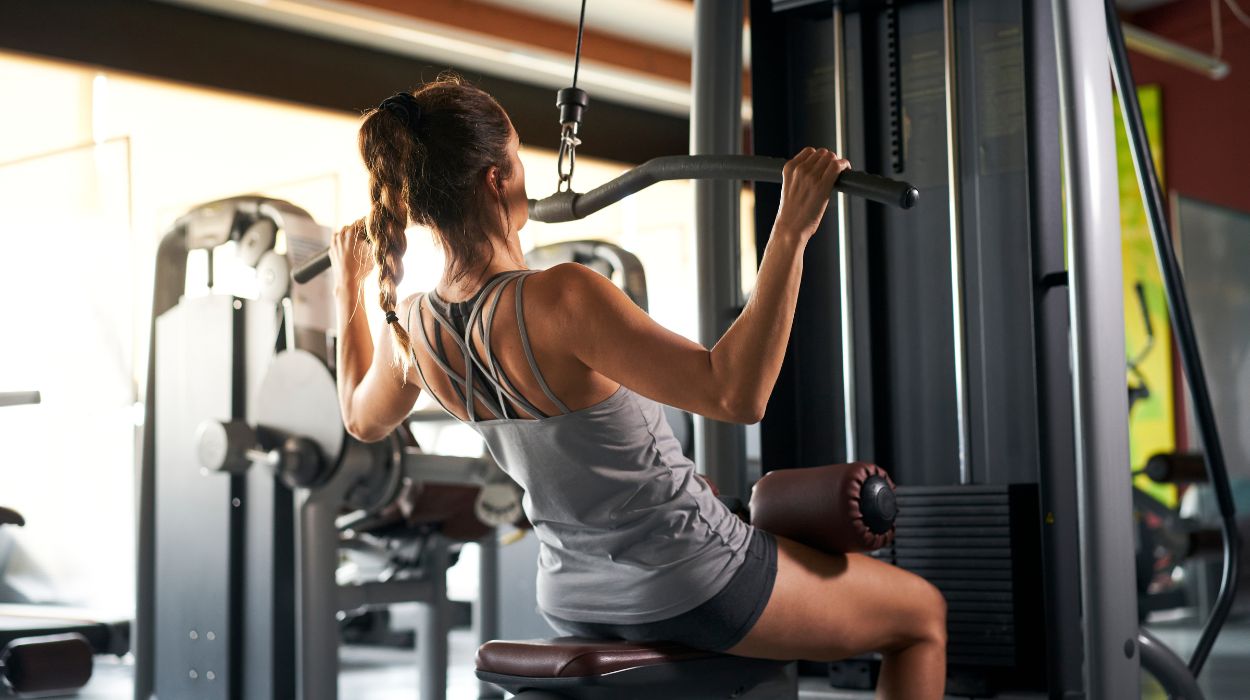
There are many potential reasons why you wouldn’t do a lat pulldown. If you don’t have shoulder mobility, the machine is taken, or you’re just simply tired of that exercise and want to switch it up. There are many other ways to target the lats and get the results you desire.
Regardless of why lat pulldowns may not be for you, strengthening your back is important for a few reasons; it helps promote better posture, supports your shoulder and spinal joints, and is one of the best ways to prevent or treat chronic back pain.[7] For improved strength and maximum muscle growth,[8] aim to get 3-6 sets of 6-12 repetitions with only a 60-second rest break between sets.
Tips For Alternatives To Lat Pulldown
For some, it can be hard to feel the lats working. It can take some time to build up your mind-muscle connection and feel that you are targeting the correct muscles. To help with this, try holding the end position for about one second to isolate the muscle. Holding this tension can help build bigger muscles.[9]
To have a great workout, you must be properly fueled. Getting a good, healthy breakfast will help you perform well at the gym. Whether your goal is to lose weight, get a lean physique, or pack on muscle mass, being properly nourished and hydrated is foundational to your journey.
Conclusion
The lat pulldown machine might be the quintessential back exercise for most, but there are so many more options out there to help build strength and increase the size of your back. Switching up your workout routine and trying different lat pulldown alternative exercises can help to keep you motivated to improve your upper body strength!
Frequently Asked Questions
In addition to the latissimus dorsi, these pulling exercises also target muscles in your upper back including your rhomboids, traps, and rear deltoids.
You can use resistance bands tied to a sturdy bar and then loop them under your feet for assisted pull-ups.
To be completely sure you have good mobility to complete these exercises, consult a physical therapist or personal trainer.
Resources
- Andersen, V., Marius Steiro Fimland, Wiik, E., Skoglund, A. and Atle Hole Sæterbakken (2014). Effects of Grip Width on Muscle Strength and Activation in the Lat Pull-Down. Journal of Strength and Conditioning Research, [online] 28(4), pp.1135–1142. doi:https://doi.org/10.1097/jsc.0000000000000232.
- Jeno SH;Varacallo M (2023). Anatomy, Back, Latissimus Dorsi. [online] Available at: https://pubmed.ncbi.nlm.nih.gov/28846224/.
- Yoshikuni Mimata, Nishida, J., Nagai, T., Tada, H., Sato, K. and Minoru Doita (2018). Importance of latissimus dorsi muscle preservation for shoulder function after scapulectomy. Journal of Shoulder and Elbow Surgery, [online] 27(3), pp.510–514. doi:https://doi.org/10.1016/j.jse.2017.09.030.
- Kraemer, W.J., Ratamess, N.A. and Nindl, B.C. (2017). Recovery responses of testosterone, growth hormone, and IGF-1 after resistance exercise. Journal of Applied Physiology, [online] 122(3), pp.549–558. doi:https://doi.org/10.1152/japplphysiol.00599.2016.
- Kraemer, W.J., Ratamess, N.A., Hymer, W.C., Nindl, B.C. and Fragala, M.S. (2020). Growth Hormone(s), Testosterone, Insulin-Like Growth Factors, and Cortisol: Roles and Integration for Cellular Development and Growth With Exercise. Frontiers in Endocrinology, [online] 11. doi:https://doi.org/10.3389/fendo.2020.00033.
- Dutton, R.A. (2021). Stress Fractures of the Hip and Pelvis. Clinics in Sports Medicine, [online] 40(2), pp.363–374. doi:https://doi.org/10.1016/j.csm.2020.11.007.
- Tataryn, N., Simas, V., Catterall, T., Furness, J. and Keogh, J.W.L. (2021). Posterior-Chain Resistance Training Compared to General Exercise and Walking Programmes for the Treatment of Chronic Low Back Pain in the General Population: A Systematic Review and Meta-Analysis. Sports Medicine – Open, [online] 7(1). doi:https://doi.org/10.1186/s40798-021-00306-w.
- Michał Krzysztofik, Wilk, M., Grzegorz Wojdała and Artur Gołaś (2019). Maximizing Muscle Hypertrophy: A Systematic Review of Advanced Resistance Training Techniques and Methods. International Journal of Environmental Research and Public Health, [online] 16(24), pp.4897–4897. doi:https://doi.org/10.3390/ijerph16244897.
- Burd, N.A., Andrews, R.J., Daniel, Little, J.P., Cochran, A.J., Hector, A.J., Joshua, Gibala, M.J., Potvin, J.R., Baker, S.K. and Phillips, S.M. (2012). Muscle time under tension during resistance exercise stimulates differential muscle protein sub-fractional synthetic responses in men. The Journal of Physiology, [online] 590(2), pp.351–362. doi:https://doi.org/10.1113/jphysiol.2011.221200.




